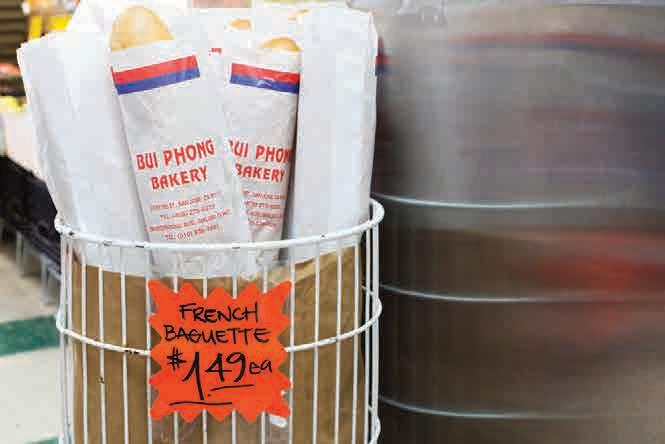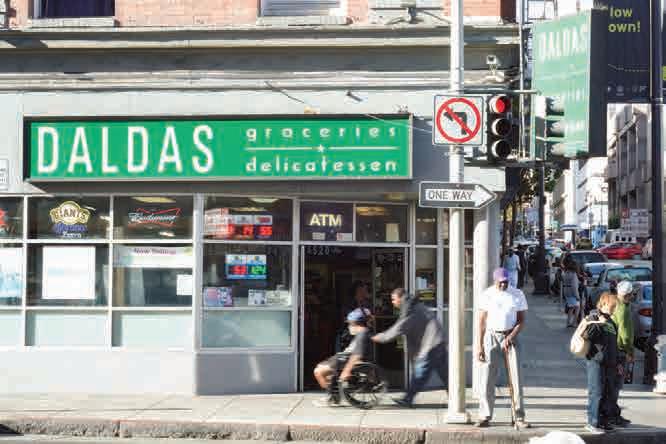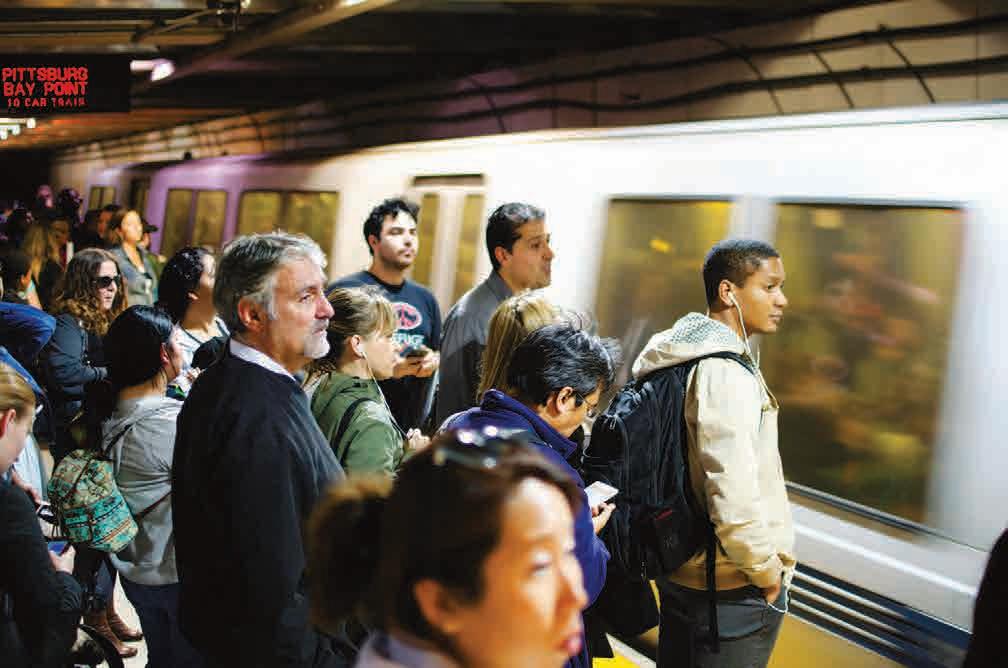
12 minute read
calculated that the 5 percent of the state’s total groundwater now is about The electricity needed to pump
The Market, an upscale 28,000-square-foot emporium and food hall, opened in January 2015 in the Twitter building at 10th and Market streets.

Advertisement
Photos by Sara Bloomberg // SF Public Press
A Tale of Two Markets
As high-price food arrives in tech epicenter, city program brings basic, fresh options to nearby Tenderloin
By Mark Hedin and Geoff Link // Central City Extra
Food justice. It’s a buzzword for access to wholesome, fresh foods for people with limited budgets and nutritional options. The contrasting corner stores that now serve both sides of Market Street show that disparities persist in San Francisco.
In January, the $4 million, 28,000-square foot supermarket called simply The Market opened in the Twitter building at the southeast corner of 10th and Market, across from the new NEMA apartments that rent for $4,200 a month and up.
At the same time, the Tenderloin is getting its best shot at emerging from its historical food desert with the publicly financed greening of traditional mom-andpops. The latest remake in what will become a string of updated stores, Daldas, has gotten an uptick courtesy of the Tenderloin Healthy Corner Stores coalition.
Daldas, about 1,800 square feet of basics at Eddy and Taylor, near Tenderloin Neighborhood Development Corp.’s way-below-market-rate Curran House for lowincome families, has converted to an oasis of healthy options displayed in new bins and on shelves provided through Supervisor Eric Mar’s 2013 ordinance creating the Healthy Food Retailer Incentives Program. A branch of the mayor’s office and the Department of Public Health coordinate with the coalition to encourage all 70 or so of the neighborhood mini-markets to offer fresh, healthy food.
With an annual budget of $60,000 to fund the program, Gloria Chan of the Mayor’s Office of Economic and Workforce Development said her department finances physical renovations with “up to $15,000” for the effort on any given store. The Department of Public Health handles administration and makes expert consultations. The coalition handles community outreach.
The majority of the Tenderloin’s corner stores had no fresh produce for sale, and all but eight carried alcohol and cigarettes.
So the incentive to bring those mangos, ginger, tomatoes, apples, bananas, cucumbers, tomatoes, potatoes, lemons, onions, garlic, peppers, lettuce, grapes and the occasional watermelon to the front of Daldas’ busy liquor store is a part of City Hall’s nod to food justice.
In the nearby fridge are waters, teas, juices, aloe, coconut beverages and kombucha, replacing wine and champagne. Deeper in the store are nuts, dry goods such as rice and beans and, in the deli case, blocks of cheese and a selection of meats — chicken and beef links, about a half-dozen different Oscar Meyer sandwich meats, hot dogs, sausages, bologna, bacon, breakfast sandwiches and barbecued beef heroes.
Chips and wine, candy, tobacco, liquor, lottery tickets and sundries as varied as batteries, toiletries, bug spray, condoms, phone chargers, headphones, cat food and even watches are all still readily available. Daldas still sees a steady stream of customers for such things, and beer distributors continue to roll in hand trucks stacked high with their products.
But nowadays, according to the development corporation’s Ryan Thayer, co-coordinator of the coalition, at least these stores’ humble selection of fruits and vegetables sell well enough that they need constant Daldas, at the corner of Eddy and Taylor streets, has a new produce section, courtesy of a healthy food program.


replenishment.
“Anything for the community,” said Satwinder “Bill” Multani, the always smiling, turbaned owner, who bought Daldas eight years ago.
A ‘FRIENDLY PLACE’
Daldas is rocking from 7 a.m. till 2 a.m., seven days a week, Satwinder said, staffed by him, his wife and two employees. Satwinder is Punjabi from northern India. He said the store, named by his predecessors, means “friendly place” in Arabic.
Although the cash register at Daldas is ensconced behind what appears to be a bullet-proof, shoulderhigh partition, and security cameras and strategically placed mirrors are plainly visible, Multani said that crime is not much of an issue for him, and that he can usually shame the occasional shoplifter with reminders that his is a community store and should be treated respectfully.
Meanwhile, across the streetcar tracks on the south side of Market Street, past the ever-present Admiral security guard at the front of The Market, its spacious aisles lead past sumptuous displays of fresh fruit and vegetables and highgrade coffee and craft beer offered at commensurate prices. There’s a butcher, baker, fishmonger and a wine shop, too.
Customers can take a seat to eat from steaming trays of prepared foods such as barbecued chicken, Cajun potatoes and roasted vegetables, all for $8 per pound. At the rear of the market is concessionaire Azalina’s, offering Malaysian food. There is also a pizzeria, a taqueria and a tapas bar with beer on tap and televisions overhead. Several other food concessions operate from alcoves — each nearly as large as Daldas’ entire space — where shoppers can peruse chocolates, ice cream and other sweets made by the local company Nuubia, which describes its “amazing signature confections” as “the best artisan indulgences in the precise French discipline” made by “the first food producer in the world to earn the right to be labeled ‘Wildlife Friendly,’ ‘Gorilla Friendly’ and ‘Palm-Oil Free.’” Beauty products maker EO Exchange operates from another alcove, at the front of the store.
“Love Life. Live Clean,” its pitch on The Market’s website urges, is so over-the-top PC that it smacks of satire: “Indulge your senses with EO natural & organic personal care, crafted with pure aromatherapeutic essential oil blends … natural, GMO-free, gluten-free, and cruelty free,” sourced from organic ingredients “whenever and wherever” possible and “formulated and manufactured” in, you guessed it, Marin County.

HAPPY-HOUR BIVALVES
There’s a sushi and oyster bar where the happy-hour bivalves go for a discounted price of $1.50 each and each glass of wine is $1 off, Market spokeswoman Elaine Trierweiler said.
In the south corner, accessible from 10th Street, is the uber-high-end Blue Bottle coffee concession.
A survey conducted by the coalition in 2013 found that the majority of the Tenderloin’s corner stores had no fresh produce for sale, although all but eight, mainly the halal markets, carried alcohol and cigarettes.
The coalition arose out of community frustrations over the inability to attract a full-scale supermarket into the neighborhood despite years of advocacy. The coalition began working with Tenderloin merchants to provide readily available fresh food.
The resultant Healthy Retail S.F. program this year is transforming three Tenderloin stores, another in the Bayview and one in Oceanview.
Last year, as the program finally got under way, Radman’s, at 201 Turk St., was the first corner store to get made over. Supervisor Jane Kim this year presented owner Fadhl Radman with the Brother Kelly Cullen Service Award for emphasizing fresh produce, adding a meat counter and bulk bins for dry goods.
The coalition also has been working with Amigo’s Market at Ellis and Leavenworth to improve its produce display with new shelving, signage and architectural consultation on how best to use the limited space. This past summer, the MidCity Market in the 900 block of Geary has also undergone changes, most noticeably in an impressive U-shaped refrigeration unit the store helped pay for itself, along with consultation on store design, product placement and improved signage.
JOBS AT THE MARKET
At Amigo’s, the coalition also helped coordinate with the EatSF program to enable its clients, typically those at risk of chronic diseases, to use its produce vouchers, becoming one of just four stores in the Tenderloin to accept them.
The Market, adjacent to the opulent Dirty Water bar, is the site of what the mayor’s office touts as its biggest success in providing jobs for San Franciscans — those here before the tech boom, that is. A dozen District 6 residents from the Office of Economic and Workforce Development’s training programs were among the 43 hired at The Market early this year.
The jobs pay San Francisco’s minimum wage, except for one or two line cook or lead line cook spots, where the pay ranges from $15 to $17 per hour, according to city data.
That might be enough for them to afford The Market’s grass-fed ground beef at $5.99 a pound or one of its pound-size mangoes at $1.49 each — they cost 30 cents more at Daldas — but maybe not the organic tomatoes that run up to $5.49 per pound.
The Market, whose owners plan to open two more such stores in the city next year, is of a scale and location to be the neighborhood’s longed-for supermarket. But it’s not.
The city’s meager subsidy of the Tenderloin corner stores’ transformation to healthier fare is in keeping with other City Hall policy on the Tenderloin–tech interface.
Twitter and related businesses moving into mid-Market got a tax break worth tens of millions. If the bottom line is your target, Mayor Lee and Supervisor Kim hit a bull’s-eye and the Tenderloin way of life is simply collateral damage. Their giveaway lured a consumer base affluent enough to finally be able to support a neighborhood supermarket.
But The Market is a seven-digit resource, out of reach for most of those who live in the Tenderloin. Their corner stores, like Daldas, will phase in healthier fare one market at a time under the city’s investment of $15,000 per store. Local Mission Market prides itself on seasonal food and tells shoppers about the people who produce it. But the store, where prices run high, is not for everyone. Photos by Stella Sadikin // Public Press
Well-Off Foodies, Bargain-Hunters, Cruise Different Aisles
As income inequality grows, gourmet trend highlights the need for inexpensive groceries
By Caroline Cakebread // Public Press stamps and now often known as EBT (for the I f you shop at Casa Lucas and then Local Mission Market three blocks away, the contrasts of modern-day San Francisco come into sharp focus. Casa Lucas, on the Mission District’s central artery of 24th Street for 35 years, boasts a massive selection of produce, meats and traditional Latin American items, such as tamarind candy and chicharrones, near the register. You can get red potatoes for 79 cents a pound and a loaf of bread for $2.99. At Local Mission Market, which opened in 2013, pulsating house music greets shoppers, and artfully lettered chalkboards announce that everything is locally sourced and fresh. Here, red potatoes go for $1 per pound and the cheapest loaf of sandwich bread is $6.50. These stores are targeting two distinct populations with different priorities. One serves the area’s longtime Latino residents, many of whom are lower-income and need to spend as little as possible when shopping to feed their families. And its stock comes from far and wide. The other serves residents from far and wide who can afford premium prices for freshness and the cachet of buying from local vendors. The latter group can choose to shop any number of ways and in many places. But lower-income San Franciscans are increasingly unable to afford enough of the food they need to stay healthy. The San Francisco Food Security Task Force, a city-sponsored working group, reported in May that one-third of adults in the city with incomes less than double the federal poverty level were “food insecure” in 2011 through 2012. That was up from 26 percent in 2003 but down from 44 percent in 2009, the depths of the Great Recession. People are food insecure when they cannot afford or get enough nutritious food that they’re accustomed to in order to support a healthy life. electronic benefits transfer cards that recipients use) — and WIC, which serves women, infants and children. But officials have said that only about half the California families that qualify for food assistance are getting it, and many families that don’t qualify for public assistance still can’t afford sufficient nutritious food. The SF-Marin Food Bank estimated last year that families of 11,000 city public school students were eligible for CalFresh but not receiving help. Already, 30,000 families in San Francisco and Marin counties receive help from the pantries each week, and food for 107,000 meals is distributed daily. Guillermo Garcia sells at farmers markets throughout San Francisco for Edith’s Gourmet Baking Co., which is based in Modesto. He has seen shoppers cut back as his company increased bread prices to offset higher costs for flour, butter and sugar. “Before, when we had a two-for-$7 deal they would buy two loaves,” Garcia said. “Now, since we changed our prices to $4, they only buy one.” It is not just lowwage and unemployed people who cannot afford healthy groceries. “We have a sense that there are people in the middle tier who need food assistance,” said Paul Ash, executive director of the SF-Marin Food Bank. “We are trying to come up with a food-assistance model that doesn’t seem like handouts, that feels good to go get,” Ash said. “These are busy working people; they can’t stop in the middle of the day to go to a pantry at their kids’ school.” Lena Miller, who was born and raised in the Bayview, said that as a single parent of two teenagers, she has to cut into everything else to pay for food. Entertainment is gone. “You can have less food, but it’s hard to tell kids that there’s no food.” Ash said that a big obstacle to creating food security in San Francisco is the large gap “If you want to come in and take advantage of the highend population, then you’ve got to make sure people across the city are fed.” Paul Ash executive director, SF-Marin Food Bank SUBSIDIES FALL SHORT OF NEED between the maximum income that CalFresh recipients can earn and what it takes to be selfLow-income state residents struggling to put food on their tables can get help through two federally funded programs: CalFresh, which administers the Supplemental Nutrition Assistance Program — formerly known as food sufficient in San Francisco. Ash urged the city to pressure businesses not to cater only to the forces of gentrification. “If you want to come in and take advantage of the high-end population,” he said, “then you’ve got to make sure people across the city are fed.”




